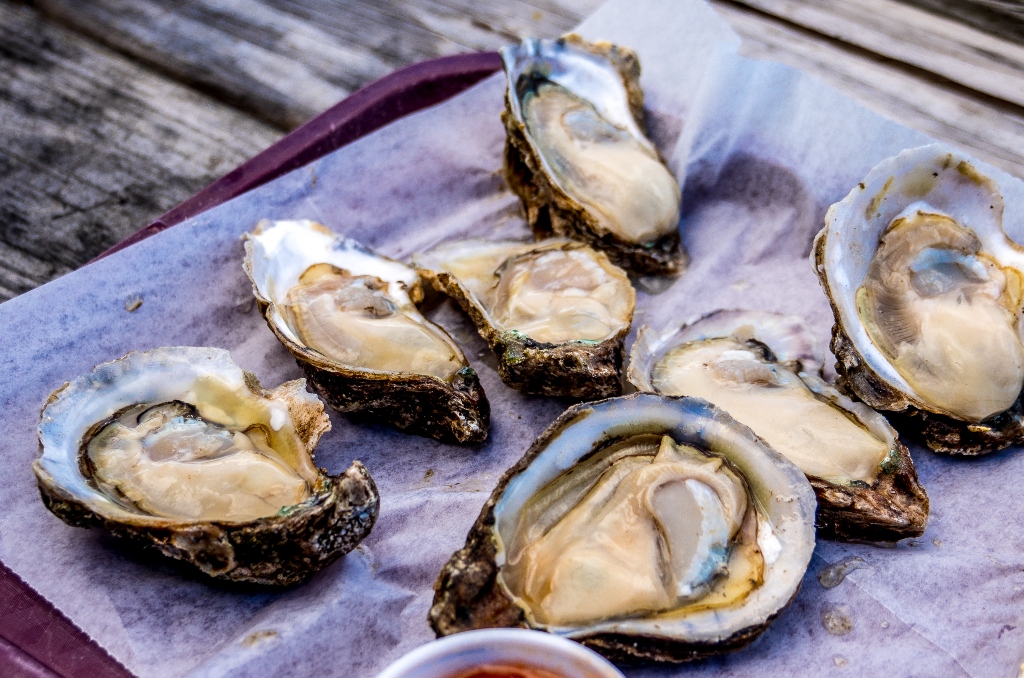World-famous Apalachicola oysters from Apalachicola, Florida, USA. Photo: Clayton Harrison/Shutterstock.com
If you’ve ever eaten oysters and wondered where they came from, look no further for your answer. In the coming paragraphs, we will give you a history, explanation and results of what the oyster has done for the economy of Florida and what the future holds for oyster farming. Maybe we’ll even give you a reason to join in on the cause to try to bring about another oyster revival in Florida like the one from back in the day.
Florida may be known as a huge tourist destination for its beaches, its weather and its residents, but no one knows (or maybe not a lot of people know) that there is money to be made here in Florida thanks to the oyster industry.
The oyster industry became a thing after Florida allowed oysters to be farmed off-bottom or in what is called “the water column.” In a water column, cages are floating on or submerged in the water. The state of Florida allowed farming up to 6 inches above the bottom of the water. This is essential: the higher up they are farmed, the less risk of predators there are and the more nutrients can be found. Oysters can grow bigger and faster the higher up they are raised.
The Florida Department of Aquaculture has issued more than 700 leases of state-owned submerged land held by a variety of companies ranging from mom-and-pop farms to larger operations, with sites circling the state from St. Johns County to Escambia County.
Wild oysters are harvested, not farmed.
This boom in oyster farming comes amid the collapse of an older, traditional wild oyster industry in Apalachicola that once supplied a tenth of the nation’s bivalves and 90 percent of Florida’s aquatic mollusks. The reason for this collapse has been due to hurricanes, overharvesting and ecological issues.
A “water-war” between Florida, Alabama and Georgia has been a big reason why the booming oyster farming industry has come from this decline of an older, traditional method of raising oysters. This feud goes back to the 1940s, when the U.S. Army Corps of Engineers built a series of five dams that restricted the flow from the Apalachicola-Chattahoochee-Flint River Basin into Apalachicola Bay. This water is needed for oysters to flourish. The case is headed to the Supreme Court now for a legal settlement.
Here’s how the process of oyster farming goes, according to Alligator Harbor, or “Oyster Boss,” one of the top oyster farmers in North Florida:
Step 1: Grow
Tiny oysters no bigger than your thumbnail are planted. Hundreds of thousands of little oysters are planted in cages and bags in the Oyster Boss farm, high above the muddy bottom of the estuary.
Step 2: Sort
In about 8 weeks, the growing baby sea mollusks are now the size of half dollars. They are then transferred altogether in larger cages to have enough room to grow to full, adult-sized oysters. As they grow in size, bigger cages are deployed by Oyster Boss watermen to house the ever-growing oysters.
Step 3: Tumble
The oysters at this point are sorted and tumbled inside of their boat-based equipment. This sorting process happens multiple times throughout the life of the oyster. This also helps keep oysters of similar size housed together in the same area on the farms.
Step 4: Flip
The oysters are flipped upside down on top of the water every 3 weeks and the shell of the oyster is allowed to dry out. This prevents the oyster from acquiring fouling-like barnacles and spat from forming on the outer shell of the oyster. This part of the process keeps the oyster looking clean and beautiful.
Step 5: Harvest
Ripe and ready to eat! The oysters are then made available to eat at local restaurants and seafood markets.
Bob Ballard, executive director at the Wakulla Environmental Institute in Crawfordville, FL, called on former Florida Governor Rick Scott in 2013 to expand aquaculture leases to include the full water column in 2013, which allowed oyster farming to take over from wild oyster harvesting. Students in aquaculture programs in universities in North Florida have taken an active interest in oyster farming while still in school. Ballard is seeking a patent for a device—an “oyster dome” made of high-strength concrete—that he believes can regenerate the state’s native oyster population, which in turn could trigger a domino effect of ecologically positive results.
“It may take five years. It’s not a light switch,” he says, but if his plan succeeds, the outcome could be a dramatic response to Florida’s plague of red tide. “Red tide skipped over Wakulla County. You put out the oysters and red tide will go away. One oyster filters 50 gallons of water a day.”
Man placing metal bag with oysters on an oyster farm. Photo: Bartosz Luczak/Shutterstock.com
American breeding places for shellfish came about in the 1970s, says “Dr. Oyster” Bill Walton, an associate professor at Auburn University’s Shellfish Lab on Dauphin Island, Alabama.
“Our region is behind because we’re the part of the country that still had abundant wild oysters,” he says. “It’s tremendous to see Florida come on board and grow quickly.”
“Dr. Oyster” Walton full-heartedly believes Florida is perfectly capable of producing world-class oysters that can be featured on the menu in restaurants in New York, Chicago, Washington or Boston. Thanks to heavily-regulated water in the state, Walton thinks many opportunities are available for any and all oyster farmers in the state.
The Florida Panhandle currently has the best waters for oyster farming. So far, the Panhandle waterways and beaches have little to no human contact. Cleaner water is idle for better-quality oysters. It is one of the few places in Florida where it has not been transformed by tourism and become a residential-commercial area for tourists and locals alike.
Melissa’s career in writing started more than 20 years ago. Today, she lives in South Florida with her husband and two boys.

